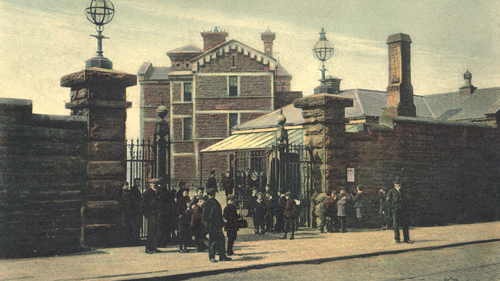Maryhill - Times Past

In partnership with the Glasgow Times, our archivists are exploring Glasgow's fascinating history. This week, Nerys Tunnicliffe writes about Maryhill.
Originally outside of the city boundaries Maryhill grew from lands of various gentry estates into a thriving village, then into a burgh, only being absorbed into Glasgow in 1891.
The name Maryhill is connected to the Gairbraid estate lands that form part of the area. Gairbraid House stood until the 1920’s and the modern day Gairbraid Avenue aligns to the original carriage way to the house. In the 1700’s the estate and house were owned by Mary Hill and her husband Robert Graham. The couple feud lands in 1791 on condition the future ‘town’ was named after Mary.
It was really the construction of the Forth and Clyde Canal in 1790 that formed Maryhill. The canal brought access to trade and works to the locality. Previously dispersed communities settled in the area attracted by commerce and employment. Iron foundries, textile, paper and saw mills, weaving and boatyards flourished, drawing in more workers from all over Scotland and elsewhere. By 1850 the population in Maryhill had risen to around 3000. As the textile industry waned it was replaced with glass and rubber manufacture along with brewing. This variety of industry set Maryhill apart from other burghs.
All this growth led to Maryhill becoming a police burgh by popular demand (the archives include a list of signatures for the creation of the burgh) in 1856. A police office, with magistrates’ chambers, and living quarters for the first Superintendent of Police George Anderson, was built on Maryhill Road in 1857. When the Burgh Halls was built later in 1878 (designed by Duncan McNaughtan) the police office moved there, and today the former Burgh Halls house a local heritage centre.
There have been claims that Maryhill’s police force was desperately needed in the 1850’s due the lawlessness at that time! This is probably an exaggeration, as is the common tale that the Maryhill district ‘the Butney’ was so named as it was populated by convicts choosing to work on the canals rather than face transportation to Botany Bay, Australia. However, the burgh commissioners’ minutes in the archives show just as much concern for street cleanliness, building applications and public health as with crime.
Another large part of Maryhill’s history was added in 1876 with the opening of soldier’s barracks for Glasgow on the former Ruchill estate. The Maryhill Barracks covered over 30 acres including parade grounds, a hospital and a chapel all surrounded by a perimeter wall. Latterly the Highland Light Infantry were stationed there. The soldiers were a common sight at local pubs such as the Elephant and Bugle and the Roxy cinema, until the barracks closed in the 1960’s. The Wyndford Housing estate now stands on the site with the remaining gatehouse and wall.
The canal which shaped Maryhill’s long industrial heritage is still there, although most of the manufacturing has gone but the records of the schools, businesses and burgh mean the long industrial heritage isn’t forgotten.
